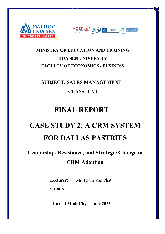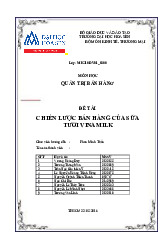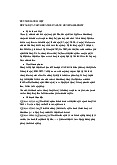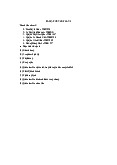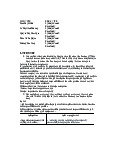




Preview text:
1. Sale management process: What is a sales program and what is Management
What is sale management process? The sales 5. Leading the sales force.
management process is the sequence of activities
What is a sales program? A Sales Program is a
that guides managers in the creation and
broad set of coordinated, repeatable and standard
administration of sales programs for a firm.
activities that drive incremental new business
The steps in the sales management process:
Ideas formulation of sales program 1. Focusing on the big picture
The formulation of a sales program 2. Roles of the sales force
The implementation of the sales program
3. Structuring the sales force.
The evaluation and control of the sales program 4. Building sales competencies
Câu 2: Component of internal environment
Goals/Objectives/Culture: Mission and
Production and Supply Chain
objectives drive customer management 1. Production capacity approaches. 2. Technology equipment
Well-defined mission + Successful corporate 3.
Location of production facilities
history + Top management values = Strong 4. Transportation costs corporate culture 5.
Ability to ensure seamless distribution and Human Resources service after the sale. 1.
Sales organizations are highly complex and
Strong Service Capabilities dynamic. 1.
Competitive advantage opportunity 2.
Often difficult to expand in response to growing 2.
Difficult for other firms to compete for same markets. customers. 3.
Outside specialists can help meet need to expand 3.
Customers reluctant to switch regardless of
Financial Resources: Lack of financial price. resources can:
R&D and Technological Capabilities
1. constrain ability to develop new products. 1.
Excellent design and engineering provide 2. limit promotional budget. promotional appeal. 3. limit size of sales force 2.
Communicating technological sophistication as
value-add helps prevents over-reliance on price for sales.
Câu 3: Selling Success Factors in Sales Management 1. Listening skills 6. Verbal communication skills 2. Follow-up skills 7.
Able to interact with people at all levels of an 3.
Ability to adapt sales style to situation. organization. 4. Tenacity 8.
Ability to overcome objections. 5. Well organized 9. Closing skills.
10. Personal planning and time management skills
Câu 4: Sales organizational structure by geographic 1.
Simplest and most common method 5.
Travel time and expenses minimized. 2.
Individual salespeople assigned to separate 6.
Sales administration and overhead costs kept geographic territories. low. 3.
Responsible for performing all activities 7.
Does not provide benefits associated with
necessary to sell all products. specialization of labor. 4. Lowest costs -
Cần phải làm gì: The geographic organization assigns salespeople to distinct territories, ensuring they
perform all necessary activities to sell company products to potential customers within the designated territory. -
Advantages: Geographic sales organization offers several advantages, including lower costs due to fewer
salespersons in smaller territories and fewer managerial levels for coordination. It also simplifies
customer relationships, as only one salesperson calls on each customer, reducing confusion about
responsibility and problem-solving. -
Disadvantages: Geographic sales organizations lack division and specialization of labor, as each
salesperson must sell all products to different customers and perform all selling functions. This structure
allows individual salespeople to make decisions, but they may focus on their best-performing functions
and most rewarding customers, despite management's objectives. -
Làm thế nào để tổ chức cái này thành công: Management can direct salespeople's efforts through
supervision, compensation plans, and policy statements, but sales reps can control the allocation of effort
across products, customers, and tasks.
Câu 5: what is the Information for sales manager?
- Sales Forecast: Projected sales for a specific period, based on historical data, market trends, current
sales pipeline, campaign planning, and performance evaluation.
- Territory Estimate: Sales potential is estimated for a specific geographic area or customer segment,
used to set quotas, allocate resources, and develop territory-specific sales strategies.
- Sales Quota: A sales target is a specific goal set for a salesperson or team, aimed at motivating them
and setting performance expectations for a specific period.
- Sales Force Size: The number of salespeople in a sales team significantly impacts budget allocation,
workload distribution, and training needs.
- Sales Territory: The assigned geographic area or customer segment allows for customized marketing
and sales strategies to meet specific customer needs.
- Market Potential: The potential sales volume for a product or service within a market is crucial for
setting realistic sales goals and identifying growth opportunities.
- Sales Potential: The sales volume a salesperson or team can achieve within their territory is used to set
individual quotas and develop territory-specific sales strategies.
- Market Share: A company's market share is a measure of its competitive performance, indicating the
percentage of the total market it captures.
Câu 6: Types of activity 1. Calls on new accounts. 6.
Equipment installations supervised. 2.
Letters to potential customers. 7. Displays arranged. 3. Proposals submitted. 8. Dealer sales meetings held. 4. Field demonstrations arranged. 9.
Meetings and conventions attended. 5. Service calls made.
10. Past-due accounts collected.
Câu 7: Steps calculate the sales force size -> Workload. Classify customer category.
Determine calculate of frequency for sales managers visit or sales call for customers. Workload Method: Breakdown Approach:
Total salespeople required = Total hours
Salesforce size = Forecasted sales : Average
required to service market : Hours available to sales per salesperson each salesperson Workload Approach:
Number of salespeople = Total selling effort
needed : Average selling effort per salesperson
Steps to determine sales force size by the workload method:
1. Classify customers into categories
2. Determine frequency and length of calls for accounts in each category
3. Calculate workload to cover entire market
4. Determine time available per salesperson
5. Apportion salesperson’s time by task performed
6. Calculate the number of salespeople needed.
Steps to calculate the number of sales staffs needed:
1. Classify customers according to different criteria
2. Determine frequency of customer meetings
3. Calculate the total number of encounters needed in the entire territory, the following formula:
Total number of meetings = Number of customers * Frequency of meetings
4. Determine the time to make the sales call
5. Calculate the number of sales calls that need to be made in a day, the following formula:
Number of sales calls = Total number of meetings / Sales call time
Câu 8: Model of the Determinant of Salesperson Performance
Câu 9: Factors Influencing the Motivation Process in Sales Management
Câu 10: Factors of Selection and Determinant for Salesperson in Sales Management
1. Establish policy concerning responsibility for - Internal sources recruitment and selection - External sources
2. Analyze the job and determine selection
4. Develop and apply selection procedures to criteria evaluate applicants - Conduct a job analysis - Application blanks - Write a job description - Interviews
- Develop a statement of job qualifications - Reference checks
3. Find and attract a pool of applications - Formal tests
Câu 11: Sales Training in Sales Management: Objectives and Topics Sales Training Objectives Sales Training Topics 1. Increase productivity 1. Product or service knowledge 2. Improve morale 2. Market/Industry orientation 3. Lower turnover 3. Company orientation 4. Improve customer relations 4. Selling skills 5. Improve selling skills 5. Time and territory management 6. Legal and ethical issues 7. Technology 8. Specialized topic.
Câu 12: Steps to conduct market profitability analysis.
Step 1: Specify purpose and determine functional cost centers.
Step 2: Spread natural account costs to functional cost centers.
Step 3: Allocate functional costs to appropriate segments using some reasonable basis.
Step 4: Sum allocate costs to determine contribution of the segments.
